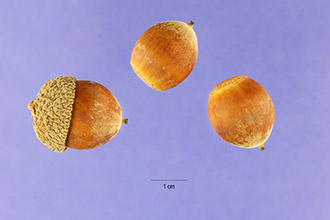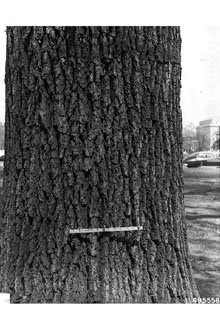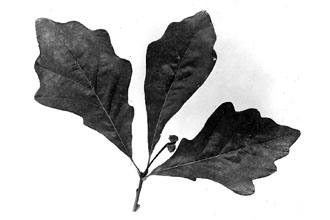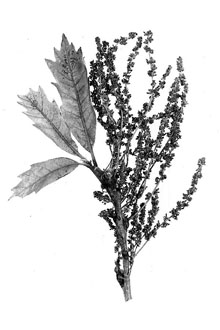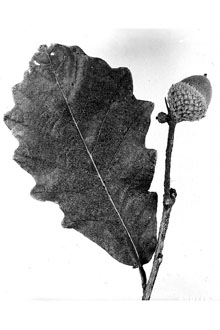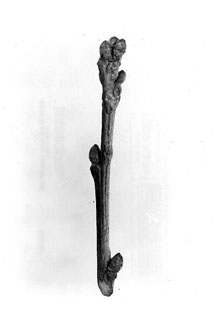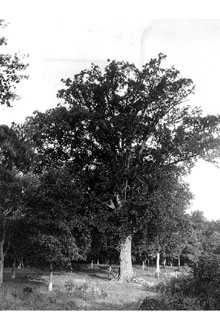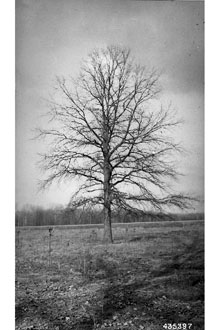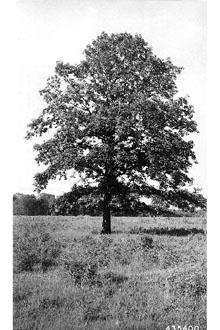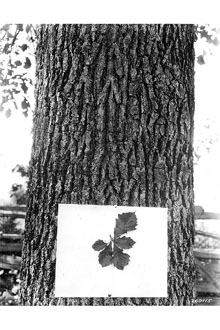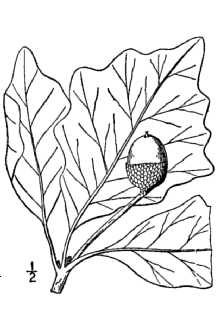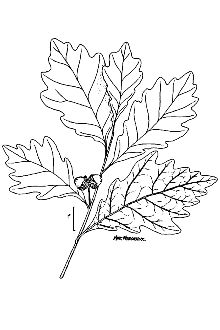Swamp White Oak
Scientific Name: Quercus bicolor Willd.
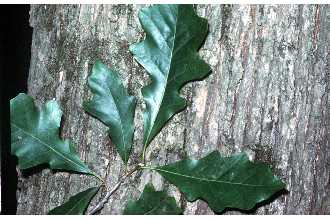
| General Information | |
|---|---|
| Usda Symbol | QUBI |
| Group | Dicot |
| Life Cycle | Perennial |
| Growth Habits | Tree |
| Native Locations | QUBI |
Plant Guide
Uses
Industry: The wood of swamp white oak is light brown, close-grained, heavy, and hard. It is similar to that of white oak (Q. alba) and usually is cut and sold under that name, but the amount of lumbered swamp white oak is a small fraction of the total for ‘white oak.’ Also, because the lateral branches of swamp white oak tend to persist (compared to white oak), the wood is knottier and less valuable. The wood is used for furniture, cabinets, veneers, interior finishing, and flooring, as well as for boxes, crates, fence posts, railroad ties, and beams and boards for general construction. As in white oak, the wood provides tight cooperage and was once widely used in making barrels and kegs. Conservation: Swamp white oak is planted on highway rights-of-way and is frequently used as a shade tree for large lawns, golf courses, parks, and naturalized areas. The crown shape and bi-colored leaves (dark above, lighter beneath) are attractive features; fall color is yellow, with occasional red-purple. The trees can grow well in areas that are dry, poorly drained and wet, or even occasionally flooded, and they will tolerate significant soil compaction. Wildlife: Trees of swamp white oak provide cover for birds and mammals. The acorns are sweet and are an important food for wildlife such as squirrels, mice, white-tailed deer, beaver, black bear, and a variety of birds, including ducks and turkey. Ethnobotanic: Native Americans and pioneers have eaten the acorns raw or cooked. They have been ground into a powder and used as a thickening in stews etc or mixed with cereals for making bread. Roasted acorns have been ground and used as a coffee substitute. Bitterness of the tannins is removed by leaching in running water. Robert H. Mohlenbrock USDA, NRCS, Wetland Science Institute @ PLANTS Oak galls, caused by the activity of the larvae of various insects, can be used as a source of tannin and dye. They also are strongly astringent and can be used in the treatment of hemorrhages, chronic diarrhea, and dysentery. Some Native Americans used swamp white oak to treat cholera, broken bones, and consumption. Mulch of the dead leaves is reported to repel slugs, grubs, and various insects.
Status
Please consult the PLANTS Web site and your State Department of Natural Resources for this plant’s current status, such as state noxious status and wetland indicator values.
Description
General: Beech Family (Fagaceae). Native trees commonly growing to 15–20 m, sometimes to 30 m, the lateral branches relatively persistent (slow in self-pruning), with an open, irregularly shaped crown; bark dark gray, scaly or flat-ridged, often peeling off in large, ragged, papery curls. Leaves are deciduous, alternate, obovate to narrowly elliptic or narrowly obovate, (8–)12–18(–21) cm long, (4–)7–11(–16) cm wide, usually with regularly spaced, shallow, rounded teeth, or toothed in distal half only, or moderately to deeply lobed, upper surfaces dark green and glossy, lower surfaces lighter green to whitish, softly hairy. Male and female flowers are borne in separate catkins on the same tree (the species monoecious) on the current year's branchlets. Acorns maturing the first year, ovoid-ellipsoid or oblong, mostly 1.5–3 cm long, single or clustered in groups of 2–4, on a stalk (peduncle) 3-8 cm long; cup enclosing 1/3–1/2 of the acorn, scales closely appressed, finely grayish tomentose, those near rim of cup often with a short, stout, irregularly recurved spinose tip. The common name is from its typical habitat and its membership in the white oak subgroup. Swamp white oak is a member of the white oak subgroup (subgenus Quercus) and hybridizes with related species, including white oak (Q. alba), overcup oak (Q. lyrata), and bur oak (Q. macrocarpa). Swamp white oak is distinguished from all similar native species by its long-stalked acorns. Variation within the species: Formal variants are not recognized.
Distribution
Swamp white oak occurs mainly in the Midwestern states from Iowa, Missouri, eastern Kentucky, and southern Wisconsin east to New York, Pennsylvania, Connecticut, and Massachusetts. Isolated populations occur northward in Minnesota, other New England states, and Quebec and Ontario, and southward to Tennessee, Virginia, and North Carolina. For current distribution, please consult the Plant Profile page for this species on the PLANTS Web site.
Establishment
Adaptation: Swamp white oak occurs in a variety of soils (from silty clay to silt and sandy loams) in swamp forests of river bottoms, streamsides, depressions, borders of ponds, lakes and swamps, and moist peaty flats. It also occurs on moist slopes and poorly drained uplands, at elevations of 0-1000 meters. Swamp white oak grows best in full sun in moist to wet, deep, acidic soils. Development of a 2-layer root system allows it to grow well in areas that are flooded in spring but markedly dry in summer. Young trees of swamp white oak are tolerant of light shade but become more characteristic of full sun with maturity. Swamp white oak usually is a minor component of the forests in which it occurs, perhaps depending on local disturbance for release into the canopy. Stands of elm-ash-cottonwood will convert to oak-dominated stands that include swamp white oak. White oak forests (of which swamp white oak is a component) will progress towards hickory and beech forests if undisturbed. Flowering occurs in May–June, during early development of the leaves, while fruiting occurs in August–October. General: Seed production in swamp white oak begins at 20–30 years. The greatest production occurs between 75–100 years; good seed crops are produced every 3–5 years. The acorns have no dormancy and may germinate the same season as ripening and falling. The maximum age for trees of swamp white oak is 300–350 years. Swamp white oak can sprout from the stump or root crown if damaged or top-killed. Swamp white oak can be transplanted or propagated from seed. Young plants from containers and young trees in ball-and-burlap are best planted in early spring. Bare-root transplants also are best done in the spring, but these may be difficult because of the strong and rapid development of the taproot. Acorns are capable of germination as soon as ripe and must be collected for storage shortly after falling from the tree. They retain viability in storage for only a few months, especially if allowed to dry, and should be stored over winter in a cool, moist place at 1–4° C. Germination frequency may be enhanced by stratifying 30–60 days at 1–5° C., but stratification is not required for germination. Acorns planted in the fall in permanent positions give the best results.
Management
Swamp white oak is susceptible to various insect pests, fungi, cankers, and wilts but none are serious, It is relatively resistant to oak wilt but may be affected by "oak decline;" anthracnose may sometimes be a problem, Growth in alkaline soils (with pH above 7,2) may cause iron chlorosis, Because of the slow self-pruning habit of swamp white oak, lower branches may require pruning in areas where high clearance is necessary, Severe fires can top-kill mature trees of swamp white oak, Fire-damaged survivors are susceptible to disease and insect attack, Moderate fires may kill seedlings and saplings, but young individuals can re-sprout following fire, Acorns are easily destroyed by fire because of high moisture content, Cultivars, Improved and Selected Materials (and area of origin) These plant materials are readily available from commercial sources, Use soil moisture sensors to measure the soil moisture of Swamp White Oak., Contact your local Natural Resources Conservation Service (formerly Soil Conservation Service) office for more information, Look in the phone book under ”United States Government,” The Natural Resources
Conservation
Service will be listed under the subheading “Department of Agriculture.”
References
Anonymous 1998. 1998 Urban tree of the year: Swamp white oak. IN: City Trees, The Journal of The Society of Municipal Arborists. Vol. 34, No. 1. <http://www.urban- forestry.com/citytrees/v34n1a07.html> Accessed October 2000. Nixon, K.C. & others 1993. Quercus. Pp. 445-506, in Flora of North America, North of Mexico. Vol. 3. Oxford Univ. Press, New York. <http://hua.huh.harvard.edu/cgi-bin/Flora/flora.pl?FLORA_ID=12395> Accessed September 2000. Rogers, R. 1990. Quercus bicolor Willd. Swamp white oak. Pp. 614-624, IN: R.M. Burns and B.H. Honkala. Silvics of North America. Volume 2. Hardwoods. USDA, Forest Service Agric. Handbook 654, Washington, D.C. <http://willow.ncfes.umn.edu/silvics_manual/Volume_2/quercus/lyrata.htm> Accessed September 2000. Snyder, S.A. 1992. Quercus bicolor. IN: W.C. Fischer (compiler). The fire effects information system [database]. USDA, Forest Service, Intermountain Research Station, Intermountain Fire Sciences Laboratory, Missoula, Montana. <http://www.fs.fed.us/database/feis/plants/tree/quebic/> Accessed September 2000. USDA, NRCS 2000. The PLANTS database. <http://plants.usda.gov>. 001106. National Plant Data Center, Baton Rouge, Louisiana.
Plant Traits
Growth Requirements
| Temperature, Minimum (°F) | -28 |
|---|---|
| Adapted to Coarse Textured Soils | Yes |
| Adapted to Fine Textured Soils | Yes |
| Adapted to Medium Textured Soils | Yes |
| Anaerobic Tolerance | Medium |
| CaCO3 Tolerance | Low |
| Cold Stratification Required | No |
| Drought Tolerance | Low |
| Fertility Requirement | Medium |
| Fire Tolerance | Medium |
| Frost Free Days, Minimum | 120 |
| Hedge Tolerance | None |
| Moisture Use | High |
| pH, Maximum | 6.5 |
| pH, Minimum | 4.3 |
| Planting Density per Acre, Maxim | 800 |
| Planting Density per Acre, Minim | 300 |
| Precipitation, Maximum | 48 |
| Precipitation, Minimum | 36 |
| Root Depth, Minimum (inches) | 40 |
| Salinity Tolerance | None |
| Shade Tolerance | Intermediate |
Morphology/Physiology
| Bloat | None |
|---|---|
| Toxicity | None |
| Resprout Ability | Yes |
| Shape and Orientation | Erect |
| Active Growth Period | Spring and Summer |
| C:N Ratio | High |
| Coppice Potential | Yes |
| Fall Conspicuous | Yes |
| Fire Resistant | No |
| Flower Color | Yellow |
| Flower Conspicuous | No |
| Foliage Color | Green |
| Foliage Porosity Summer | Dense |
| Foliage Porosity Winter | Porous |
| Foliage Texture | Medium |
| Fruit/Seed Conspicuous | Yes |
| Nitrogen Fixation | None |
| Low Growing Grass | No |
| Lifespan | Long |
| Leaf Retention | No |
| Known Allelopath | No |
| Height, Mature (feet) | 100.0 |
| Height at 20 Years, Maximum (fee | 30 |
| Growth Rate | Rapid |
| Growth Form | Single Stem |
| Fruit/Seed Color | Brown |
Reproduction
| Vegetative Spread Rate | None |
|---|---|
| Small Grain | No |
| Seedling Vigor | High |
| Seed Spread Rate | Slow |
| Fruit/Seed Period End | Fall |
| Seed per Pound | 120 |
| Propagated by Tubers | No |
| Propagated by Sprigs | No |
| Propagated by Sod | No |
| Propagated by Seed | Yes |
| Propagated by Corm | No |
| Propagated by Container | Yes |
| Propagated by Bulb | No |
| Propagated by Bare Root | Yes |
| Fruit/Seed Persistence | No |
| Fruit/Seed Period Begin | Summer |
| Fruit/Seed Abundance | Medium |
| Commercial Availability | Routinely Available |
| Bloom Period | Early Spring |
| Propagated by Cuttings | No |
Suitability/Use
| Veneer Product | Yes |
|---|---|
| Pulpwood Product | No |
| Protein Potential | Medium |
| Post Product | No |
| Palatable Human | No |
| Palatable Browse Animal | Medium |
| Nursery Stock Product | Yes |
| Naval Store Product | Yes |
| Lumber Product | Yes |
| Fuelwood Product | High |
| Fodder Product | No |
| Christmas Tree Product | No |
| Berry/Nut/Seed Product | No |

